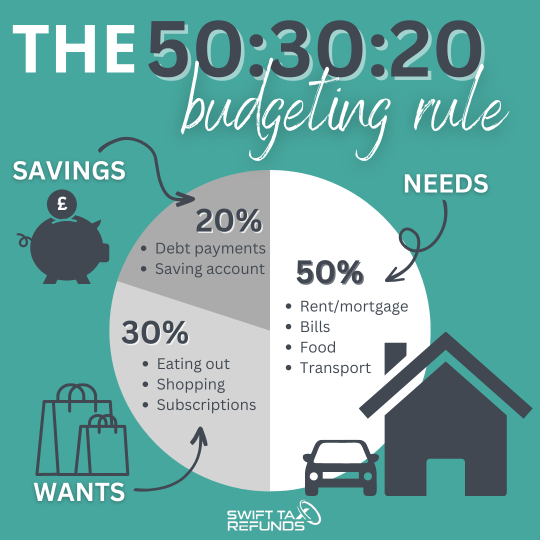Introduction
Managing personal finances can feel overwhelming, but following a simple and effective budgeting strategy can make all the difference. One such strategy is the 50/30/20 rule, a straightforward financial guideline that helps individuals allocate their income efficiently. By using this rule, you can build wealth steadily while ensuring a balance between necessary expenses, personal desires, and savings.

Understanding the 50/30/20 Rule
The 50/30/20 rule is a budgeting method that divides your after-tax income into three categories:
- 50% for Needs: Essential expenses such as rent, utilities, groceries, insurance, and minimum debt payments.
- 30% for Wants: Discretionary spending, including entertainment, dining out, hobbies, and vacations.
- 20% for Savings and Debt Repayment: Investments, emergency funds, retirement savings, and paying off debt beyond the minimum payment.
This simple framework ensures that you cover your necessities, enjoy life, and still work toward financial stability.
How the 50/30/20 Rule Helps in Wealth Building
1. Encourages Financial Discipline
By categorizing expenses, the 50/30/20 rule helps you control impulsive spending and ensures that a portion of your income is dedicated to wealth-building activities.
2. Promotes Healthy Saving Habits
Allocating 20% of your income to savings and investments means you consistently contribute toward financial goals such as retirement, an emergency fund, or a down payment on a home.
3. Balances Lifestyle and Financial Goals
Unlike restrictive budgeting methods, this rule allows for personal enjoyment (30% for wants) while keeping you on track to achieve long-term financial security.
4. Helps in Debt Management
Setting aside 20% of your income for savings and debt repayment enables you to pay off loans faster, reducing interest payments and financial stress.
5. Creates a Strong Financial Foundation
By ensuring that necessities are covered (50%) and savings are prioritized (20%), the rule provides a roadmap for financial stability, making it easier to handle unexpected expenses.
Tips for Implementing the 50/30/20 Rule
- Track Your Income and Expenses: Use budgeting apps like Mint, YNAB, or spreadsheets to monitor spending.
- Adjust as Needed: Depending on your income and location, you might need to tweak the percentages slightly.
- Automate Savings: Set up automatic transfers to your savings and investment accounts to ensure consistency.
- Cut Unnecessary Expenses: Review your wants category and identify areas where you can save more.
Read More:https://wealthfitlife.com/how-to-maximize-your-portfolio-for-long-term-growth/
FAQs
1. Who created the 50/30/20 rule?
The rule was popularized by U.S. Senator Elizabeth Warren and her daughter Amelia Warren Tyagi in their book All Your Worth: The Ultimate Lifetime Money Plan.
2. Does the 50/30/20 rule work for everyone?
While it’s a great starting point, some people may need to adjust the percentages based on their income level and living expenses.
3. How do I calculate my 50/30/20 budget?
Take your after-tax income and divide it into 50% for needs, 30% for wants, and 20% for savings and debt repayment.
4. Can I use the 50/30/20 rule if I have a low income?
Yes, but you may need to allocate a higher percentage to needs and a lower percentage to wants until your income increases.
5. What if my needs exceed 50% of my income?
Consider cutting discretionary spending, finding ways to increase income, or relocating to a more affordable area if possible.
6. Should I include retirement contributions in the 20% savings category?
Yes, retirement savings, emergency funds, and investments all fall under the 20% savings category.
7. Can I follow the 50/30/20 rule if I have debt?
Yes, but prioritize paying off high-interest debt while still saving a portion of your income.
8. What budgeting tools can help implement the 50/30/20 rule?
Apps like Mint, YNAB, and PocketGuard can help track expenses and ensure you’re sticking to your budget.
9. How often should I review my budget?
Review your budget monthly to make adjustments based on changes in income or expenses.
10. What happens if I can’t stick to the 50/30/20 rule every month?
It’s okay to adjust when needed. The key is to maintain a balance between spending and saving over the long term.
Conclusion
The 50/30/20 rule is a simple yet powerful budgeting strategy that helps individuals gain financial control, save effectively, and build wealth over time. By following this approach, you can maintain a balanced lifestyle while ensuring financial security and future prosperity. Start implementing this rule today to take charge of your financial future!
